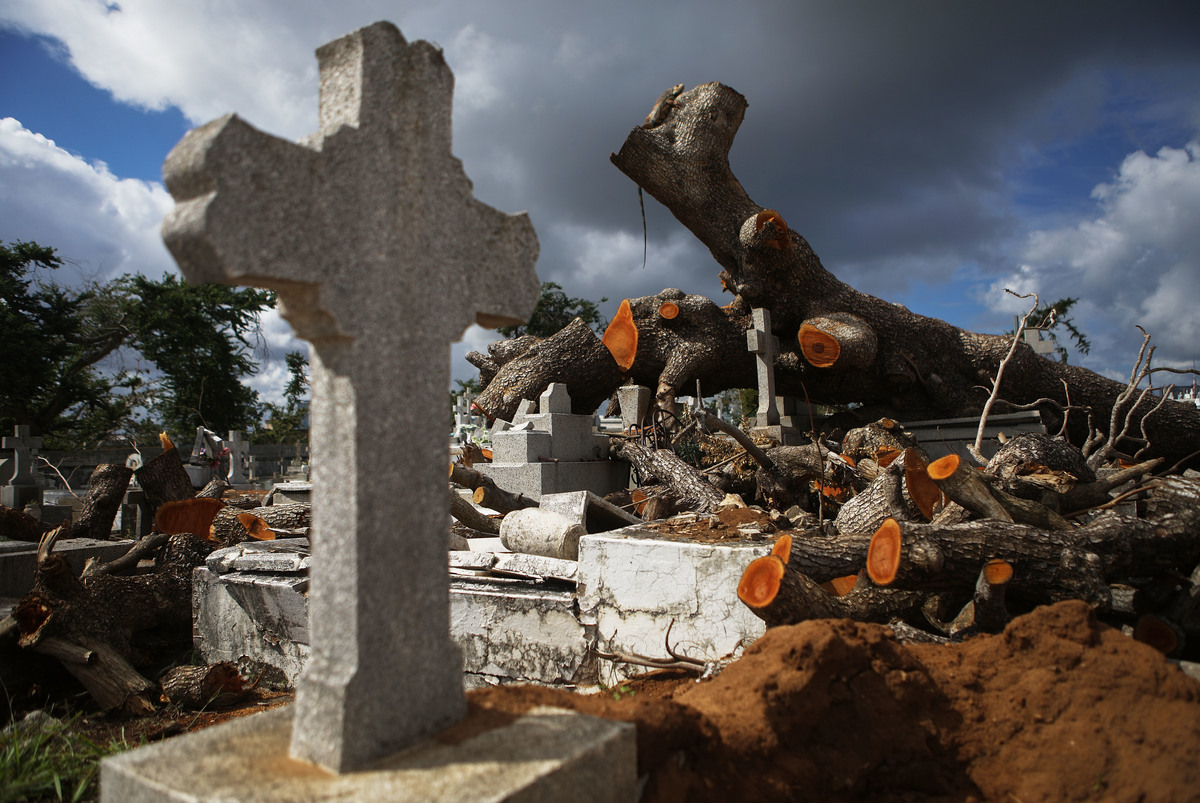
Mario Tama/Getty Images

A tree toppled by Hurricane Maria rests over damaged graves in the Villa Palmeras cemetery in San Juan, Puerto Rico, in December 2017.
Perhaps 5,000 people died in Puerto Rico in 2017 for reasons related to September’s Hurricane Maria, according to a study that dismisses the official death toll of 64 as “a substantial underestimate.”
A research team led by scientists at the Harvard T.H. Chan School of Public Health didn’t simply attempt to count dead bodies in the wake of the powerful storm. Instead, they surveyed randomly chosen households and asked the occupants about their experiences.
From that approach, they concluded that between Sept. 20 and Dec. 31, 2017, there were 4,645 “excess deaths” — that is, deaths that would not have occurred if the island hadn’t been plunged into a prolonged disaster following the devastating storm.
But the estimate isn’t as precise as the figure implies. The researchers calculate there is a 95 percent likelihood the death toll was somewhere between about 800 and 8,500 people. They say about 5,000 is a likely figure.
The findings are being published Tuesday by The New England Journal of Medicine.
The research team randomly selected 3,299 households in Puerto Rico. Local scientists surveyed them over the course of three weeks in January. People in those homes reported a total of 38 deaths. The scientists then extrapolated that finding to the island’s total population of 3.4 million people to estimate the number of deaths. The researchers then subtracted deaths recorded during that same period in 2016 and concluded that the mortality rate in Puerto Rico had jumped 62 percent in the three months following the storm.
The death rate is a contentious subject, in part because federal and island governments haven’t responded as rapidly to the disaster as they have in other hurricane emergencies. The study notes that 83 percent of the households in Puerto Rico were without electrical power for the time period looked at, more than 100 days, from the date of the hurricane until the end of 2017.
CNN surveyed funeral homes after the storm and tallied 499 hurricane-related deaths. The New York Times compared official death records from September and October 2017 and identified more than 1,000 excess deaths, compared with the average for 2015 and 2016. Alexis Santos, a researcher at Penn State University, and a colleague, used death certificates to come up with a similar estimate.
The government of Puerto Rico commissioned researchers from George Washington University’s Milken Institute School of Public Health to estimate excess deaths. Results of that study have been delayed and are due out this summer. “We have always expected the number to be higher than what was previously reported,” said Carlos Mercader, executive director of the Puerto Rico Federal Affairs Administration. He says that’s why it commissioned the study from GW. “Both studies will help us better prepare for future natural disasters and prevent lives from being lost.”
Caroline Buckee, a lead author of the news and epidemiologist at the Harvard T.H. Chan School of Public Health, says, “Our approach is complementary to that and it provides a different kind of estimate and a different kind of insight into the impact of the hurricane.” The researchers suggested that the government in Puerto Rico could use its methods in an even larger survey to reduce the large uncertainties in their findings.
The Harvard study covers a greater time period than The New York Times’ calculation, a difference that could partly account for the much higher figure.
The household survey is a widely accepted technique for estimating casualties following a disaster. But it can be misleading if the sample isn’t truly random or if some households have been wiped out altogether and are therefore missing from the survey. In the latter, the result would underestimate the true toll. In fact, the Harvard team says its results are “likely to be an underestimate” because of this bias.

COMMENTS